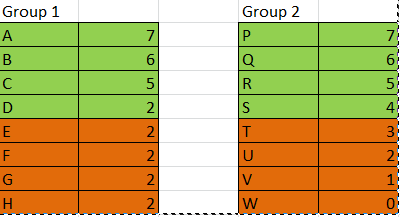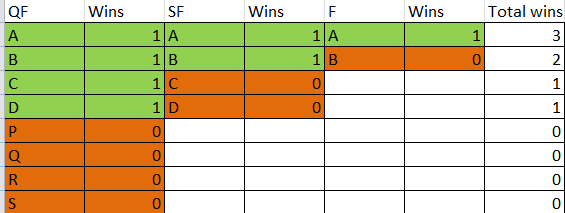CAT 2000 Question Paper
Directions for the next 5 questions:
Sixteen teams have been invited to participate in the ABC Gold Cup cricket tournament. The tournament is conducted in two stages. In the first stage, the teams are divided into two groups. Each group consists of eight teams, with each team playing every other team in its group exactly once. At the end of the first stage, the top four teams from each group advance to the second stage while the rest are eliminated. The second stage comprises of several rounds. A round involves one match for each team. The winner of a match in a round advances to the next round, while the loser is eliminated, The team that remains undefeated in the second stage is declared the winner and claims the Gold Cup.
The tournament rules are such that each match results in a winner and a loser with no possibility of a tie. In the first stage a team earns one point for each win and no points for a loss. At the end of the first stage teams in each group are ranked on the basis of total points to determine the qualifiers advancing to the next stage. Ties are resolved by a series of complex tie-breaking rules so that exactly four teams from each group advance to the next stage.
The minimum number of wins needed for a team in the first stage to guarantee its advancement to the next stage is:
What is the highest number of wins for a team in the first stage in spite of which it would be eliminated at the end of first stage?
Directions for the next 5 questions: Answer the questions with reference to the table given below: Information Technology Industry in India (Figures are in million US dollars)

The total annual exports lay between 35 and 40 percent of the total annual business of the IT industry, in the years:
The highest percentage growth in the total IT business, relative to the previous year was achieved in:
Additional instructions:
For any activity A, year X dominates years Y if IT business in activity A, in the year X, is greater than the IT business, in activity A, in the year Y. For any two IT business activities, A & B, year X dominates year Y if:
a) The IT business in activity A, in the year X, is greater than or equal to the IT business, in activity A in the year Y,
b) The IT business in activity B, in the year X, is greater than or equal to the IT business in activity B in the year Y and
c) There should be strict inequality in the case of at least one activity.
For the IT hardware business activity, which one of the following is not true?
Additional instructions:
For any activity A, year X dominates years Y if IT business in activity A, in the year X, is greater than the IT business, in activity A, in the year Y. For any two IT business activities, A & B, year X dominates year Y if:
a) The IT business in activity A, in the year X, is greater than or equal to the IT business, in activity A in the year Y,
b) The IT business in activity B, in the year X, is greater than or equal to the IT business in activity B in the year Y and
c) There should be strict inequality in the case of at least one activity.
For the two IT business activities, hardware and peripherals, which one of the following is true?







